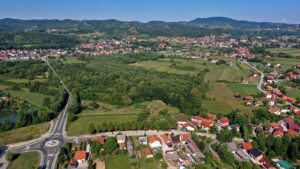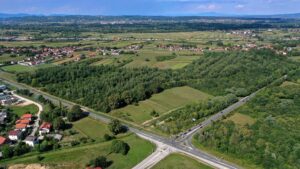Nestled in the heart of Zagreb County, the picturesque town of Samobor offers more than just cultural heritage and natural beauty.
Located in the heart of Croatia, Zagreb County, with the picturesque town of Samobor as one of its gems, presents a compelling case for investors. The region combines historical charm, economic potential, and strategic advantages, making it an attractive destination for local and foreign investors. Zagreb County, surrounding the nation’s capital, is one of Croatia’s most economically developed areas. It boasts a diversified economy with vital manufacturing, trade, tourism, and information technology sectors. The proximity to Zagreb, the country’s political, economic, and cultural centre, significantly enhances the county’s investment appeal.

Samobor, a historic town known for its cultural heritage and natural beauty, plays a pivotal role in the county’s economic framework. Its strategic location near the Slovenian border and significant transportation routes enhances its accessibility and economic integration within the region. Nestled in the foothills of the Samobor Hills and surrounded by lush forests and rolling landscapes, this charming town is a favoured destination for tourists and locals alike. However, beyond its aesthetic and historical allure, Samobor plays a significant role in the economic tapestry of Zagreb County. This essay explores Samobor’s economic landscape, focusing on its main economic activities, development strategies, and prospects.
Samobor’s long history dates back to the 13th century, and this historical depth has shaped its economic foundations. The town’s economy was traditionally based on agriculture, crafts, and trade. The fertile lands around Samobor facilitated the cultivation of various crops and vineyards, while the town became known for its craftsmanship in areas such as pottery, glassmaking, and confectionery. Samobor’s strategic location near major trade routes also contributed to its economic growth, making it a bustling market town.
In contemporary times, Samobor’s economy is diverse, encompassing tourism, manufacturing, and services. Initiatives to support local businesses include providing financial incentives, simplifying administrative procedures, and offering training programs. These measures aim to foster entrepreneurship and innovation, helping SMEs to thrive in a competitive market. Collaboration with educational institutions ensures that the local workforce is skilled and capable of meeting the demands of modern industries. Looking ahead, Samobor’s economic prospects are promising. The ongoing development of infrastructure and continuous efforts to boost tourism are expected to drive growth. The town’s strategic location near Zagreb positions it well to benefit from regional economic trends and investments. Moreover, the emphasis on sustainable development and environmental conservation aligns with global economic shifts towards greener economies.
However, challenges remain. Ensuring balanced development that preserves the town’s cultural and natural heritage while fostering economic growth is crucial. Additionally, addressing potential issues such as traffic congestion and the pressure on local services due to increasing tourism is necessary to maintain residents’ quality of life. Samobor is a town where history and modernity converge, creating a unique economic landscape. Its rich cultural heritage, vibrant tourism sector, and diverse industries make it a key player in the economy of Zagreb County. Through strategic development and a focus on sustainability, Samobor is poised to continue its growth, contributing to the region’s prosperity while preserving the charm and character that make it a beloved destination.

Amidst this economic tapestry lies the Bobovica 2 Business Zone, a significant opportunity for investment and development. The Zone is strategically positioned along the state road from Samobor to the ‘Small’ Bregana border crossing and the access road to the Bregana-Lipovac highway (European route E70; Croatian route A3). Located just 1.9 kilometres from the highway entrance, it offers exceptional connectivity. The Zone extends along the Bregana-Samobor-Sveta Nedelja state road, is 23 kilometres from the Zagreb West railway station, 38 kilometres from Franjo Tuđman Airport, and 169 kilometres from the Port of Rijeka.
The Bobovica 2 Business Zone covers 21 hectares of state-owned land earmarked for future economic activities. The land’s ownership by the Republic of Croatia adds a layer of stability and confidence for investors. Despite the absence of current economic activities, the Zone’s infrastructure potential is promising. The communal fee for manufacturing activities is €6.67 per cubic meter, while the utility fee is €4.08 per square meter. Notably, there are significant utility fee exemptions: 100% in the first year, 50% in the second, and 25% in the third year. Additionally, the water fee is set at €0.04 per square meter.
The building regulations within the Zone are also attractive. The Building Coverage Ratio (BCR) is 0.4, the Floor Area Ratio (FAR) is 2, and the building height limit is 12 meters. These parameters provide ample flexibility for various industrial and commercial developments.
Bobovica 2 Business Zone investors can leverage the strategic location, robust infrastructure, and attractive financial incentives. As Zagreb County continues to grow and develop, zones like Bobovica 2 offer a unique opportunity to capitalize on the region’s economic momentum. The combination of Samobor’s cultural allure and the business-friendly environment of the Zone sets a promising stage for future investments, fostering economic growth and development in this historic yet forward-looking part of Croatia.
You can find additional information about Sveti Ivan Zelina and other greenfield locations in Zagreb County at www.greenring.biz